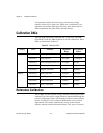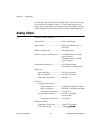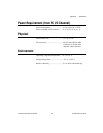
Appendix A Specifications
AT-MIO-16X User Manual A-4
©
National Instruments Corporation
Nonlinear Errors
Relative accuracy is a measure of the (non)linearity of an analog
system. It indicates the maximum deviation of the averaged
analog-input-to-digital-output transfer curve from an endpoint-fit
straight line. If the analog circuitry has been calibrated perfectly, then
the endpoint-fit straight line is the ideal transfer function, and the
relative accuracy specification indicates the farthest deviation from the
ideal that the system permits.
Differential nonlinearity (DNL) is a measure of deviation of code
widths from their theoretical value of 1 LSB. The width of a given code
is the size of the range of analog values that can be input to produce that
code, ideally 1 LSB. A specification of ±1 LSB differential nonlinearity
ensures that no code has a width of 0 LSBs (that is, no missing codes)
and that no code width exceeds 2 LSBs. DNL is measured using
histograms.
Noise
System noise is the amount of noise (in LSB rms) in the ADC data when
there is no signal present at the input of the board. This figure includes
the quantization noise of the ADC.
Analog Data Acquisition Rates
Single-Channel Acquisition Rates
The maximum single-channel data acquisition rate of the AT-MIO-16X
is 100 ksamples/sec (10-µsec sample period). The AT-MIO-16X may
run as fast as 111 ksamples/sec (9-µsec sample period), but with
unspecified accuracy.
Table A-2.
Equivalent Gain Errors in 16-Bit Systems
Range
Error at Full-Scale Gain Error
LSB % of FSR % of Gain PPM of Gain
0 to 10 V 1 0.001526% 0.001526% 15.26 ppm
–10 to 10 V 1 0.001526% 0.003052% 30.52 ppm


















